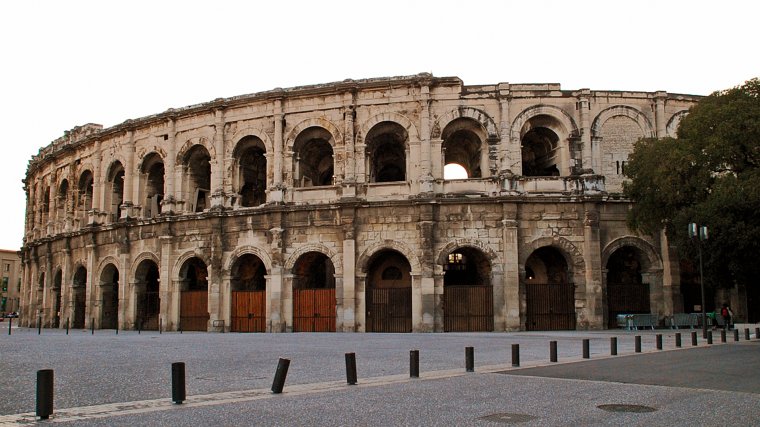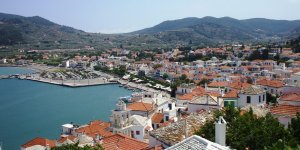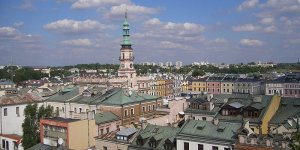| Published in Destinations |
Nimes, France

Les Arenes (Roman Ampitheatre). A well preserved Roman arena that hosts bull fighting festivals in September. It was built 100 AD to seat 24,000 spectators It currently seats 10,000 when full and is an amazing site. Nimes, France. Photo: Cătălin Kislinger / Titi Tudorancea Bulletin.
Nîmes is a city with a population of around 137,000 in the département of Gard in the south of France. It has a stunning Roman Coliseum that is second only to Rome's. There are a few other fine Roman relics and Diana's Palace. Nîmes has a rich history, dating back to the Roman Empire when the city was home to 50,000–60,000 people. Several famous monuments are in Nîmes, such as the Nîmes Arena and the Maison Carrée. Because of this, Nîmes is often referred to as the French Rome.
Climate
Nîmes has a mediterranean climate that is one of the warmest in France. Its slightly inland, southerly location results in hot air over the city during summer months (max. 41.6°C, 106.9°F), whereas winters are cool to mild but not cold (min. 9.2°C, 48.6°F).
What to See and Do in Nîmes
The three main Roman sites in Nîmes are the Maison Carrée, Magne Tower and the famous Amphitheatre. A combined ticket can be purchased for all three for €12 (€10 for children (7-17) or students), only €2 more than the single entry for the Amphitheatre. There is also a combined ticket which includes the Roman Theatre of nearby Orange. Other key sites include the Temple of Diane and the Nîmes Cathedral, both of which are free.
• Castellum. A former reservoir at the end of the 50km aqueduct.
• Cathédrale Notre-Dame-et-Saint-Castor de Nîmes (Nîmes Cathedral). The main cathedral of the city originates from the 11th century, but has been renovated and adapted many times since. It is believed it was built on top of the former Roman Temple of Augustus of which no trace remains. The building is an interesting mix of Romanesque and neo-Gothic styles.
• Jardin de la Fontaine (Fountain Gardens). March/September: 07:30-20:00, October-February: 07:30-18:30, April-August: 07:30-22:00. These beautiful gardens were created in 1745, becoming the first public park in France and one of the first in Europe. It is decorated with a number of waterways and fountains, beautiful statues from Montpellier and the ruins of the Roman Temple of Diane. Climbing the steps or ramps at the back of the park up to the highest point in Nîmes, one finds the Magne Tower. Free.
• Les Arènes (Roman Amphitheatre), Place des Arènes, ☎ +33 4-66-76-77. 9 am - 12.30 pm and 2 pm - 6 pm. a well preserved Roman arena that hosts bull fighting festivals in September. It was built 100 AD to seat 24,000 spectators It currently seats 10,000 when full and is an amazing site.
• Maison Carrée (Square House), ☎ +33 (0)4 66 21 82 56. One of the best preserved Roman temples in the former Roman Empire is to be found here in Nîmes. It was constructed approximately 2 CE, not long after the founding of the city by Emperor Augustus. The small interior comprises of a modern theatre, where a well-produced and informative film called Nemausus plays every half an hour on the half hour, giving a good introduction to the early history and foundations of the city. Adult €6, child (7-17)/student €5.
• Porte d'Auguste (Auguste Gate). Once was the main entrance to the city.
• Porte de France.
• Temple de Diane (Temple of Diane).
• Tour Magne (Magne Tower).
• Le Pont du Gard. If you haven't had your fill of Roman constructions, this impressive aqueduct is 25km up the A9 from Nimes and clearly signposted from the motorway. In Roman times the aqueduct carried water destined for Nimes.
• Musée du vieux Nîmes, 04 66 36 00 64.
• Cathédrale de Saint Castor, in place aux Herbes. City's most appealing museum.
• Musée archéologique, Blvd 13 Amiral Courbet. Columns, mosaics, sculptures, etc.
• Musée des Beaux-arts, Rue de la cité Foulc 20-22. Flemish, Italian, French works as well as Roman Mosaic.
Office de Tourisme et des Congrès, 6 rue Auguste, ☎ +33 4 66 58 38 00. July and August: Monday to Friday: 9.00 to 19.30, Saturday: 9.00 to 19.00, Sundays and public holidays: 10.00 to 18.00; April to September: Monday to Saturday: 9.00 to 19.00, Sundays and public holidays: 10.00 to 18.00; October to March: Monday to Friday: 9.00 to 18.30, Saturday: 10.00 to 18.00, Sundays and public holidays: 10.00 to 17.00.
The Office de Tourisme prints a "Bienvenue" booklet (in English) each year, which isn't available off the shelf, unless you specifically ask for it. It contains lists of Hotels, Camp Sites, Restaurants and bars. They also print a Travel Guide with descriptions of the sights to see in Nimes. There is also an information point at the Esplanade Charles-de-Gaulle.
Transportation
Nîmes-Alès-Camargue-Cévennes Airport serves the city. The Gare de Nîmes is the central railway station, offering connections to Paris (high-speed rail), Marseille, Montpellier, Narbonne, Toulouse, Perpignan, Figueras in Spain and several regional destinations. The motorway A9 connects Nîmes with Orange, Montpellier, Narbonne, and Perpignan, the A54 with Arles and Salon-de-Provence. (Wikivoyage, Wikitravel, Wikipedia)

Nimes, France. Photo: Cătălin Kislinger / Titi Tudorancea Bulletin

Nimes, France. Photo: Cătălin Kislinger / Titi Tudorancea Bulletin.
YOU MAY ALSO LIKE




 If you own or manage a travel-related business such as a hotel, a bed-and-breakfast, a restaurant, a pub or a cafeteria, you can create a web page for your business for free on Titi Tudorancea Travel Info. » |

